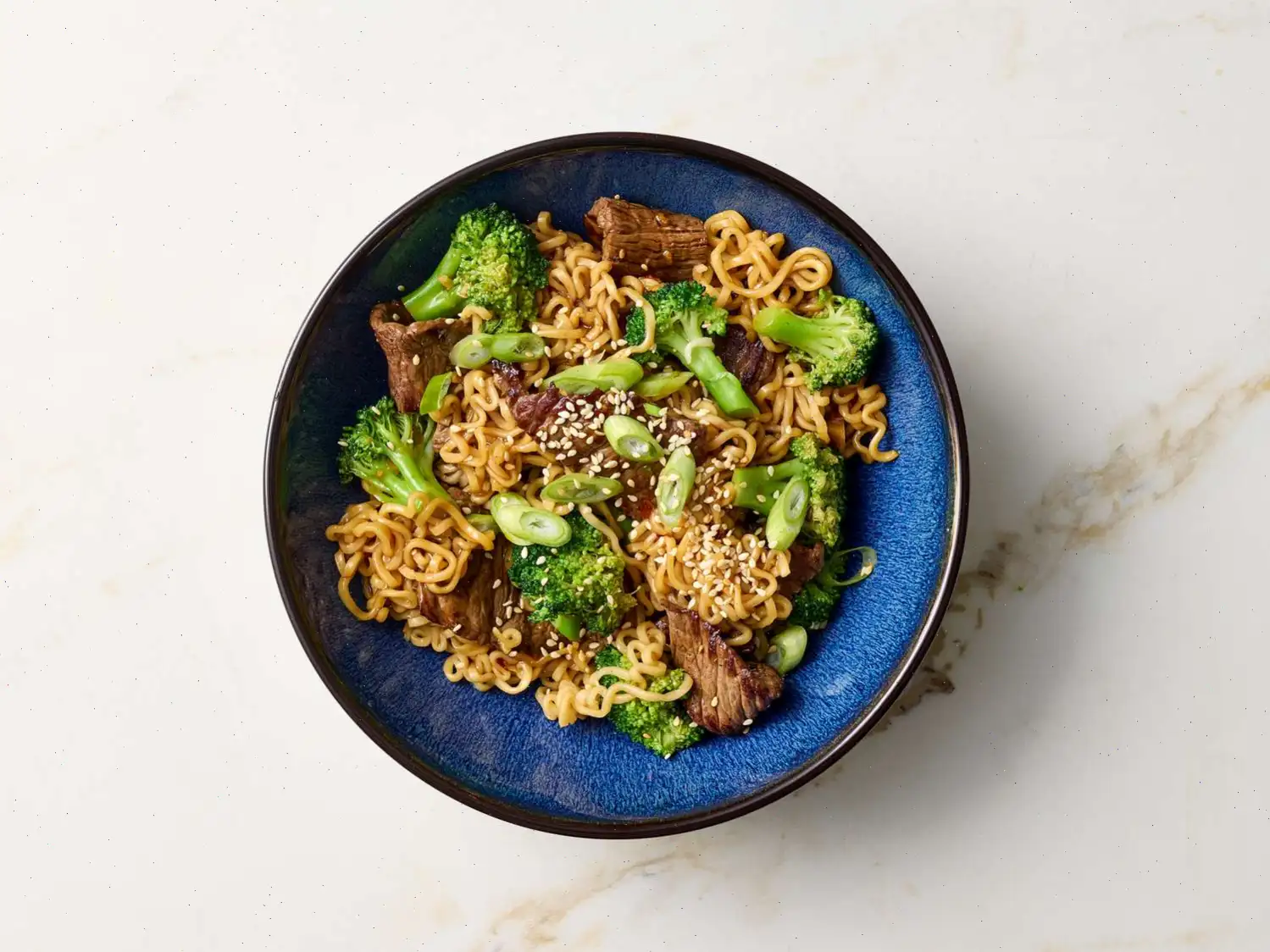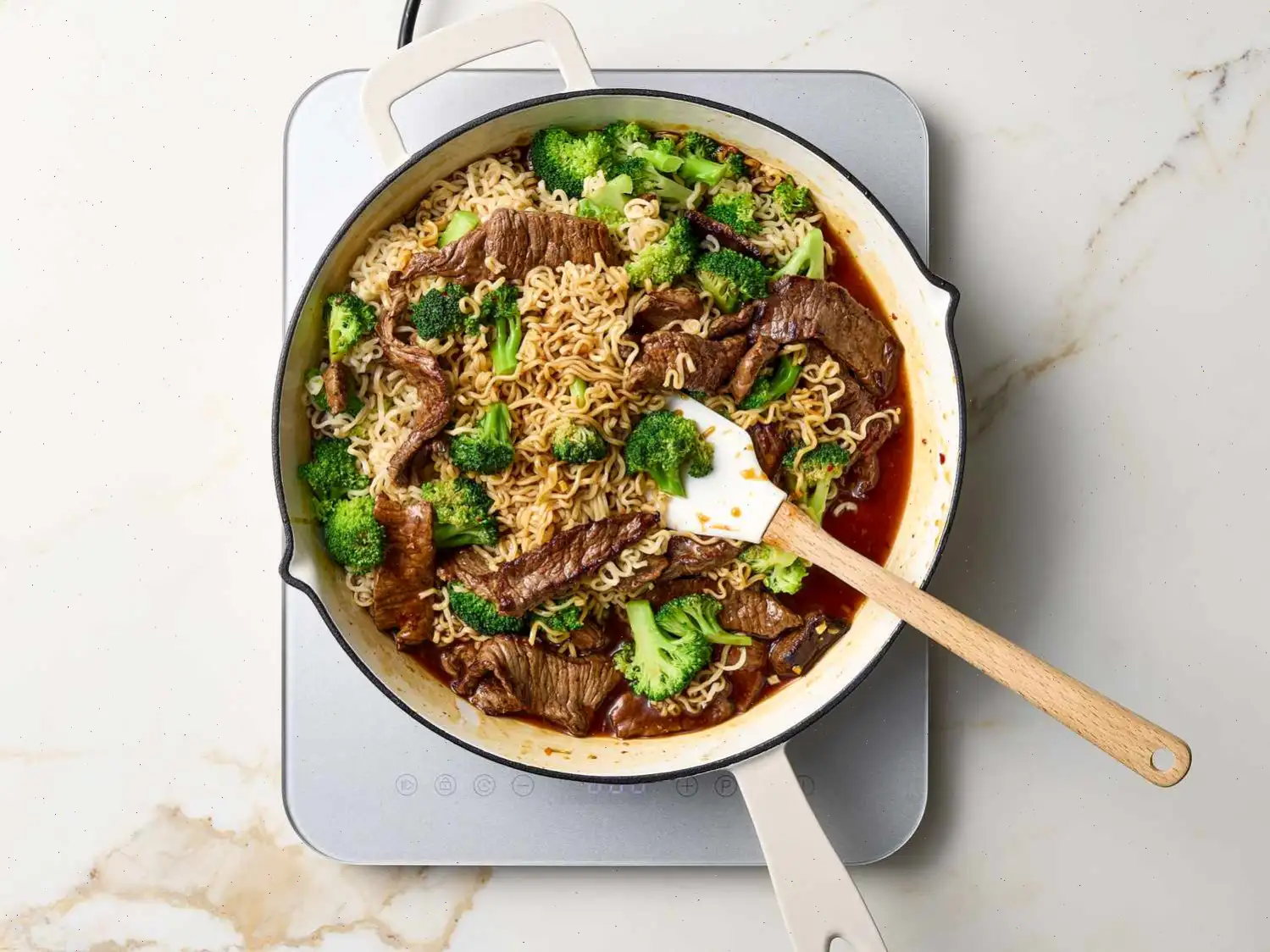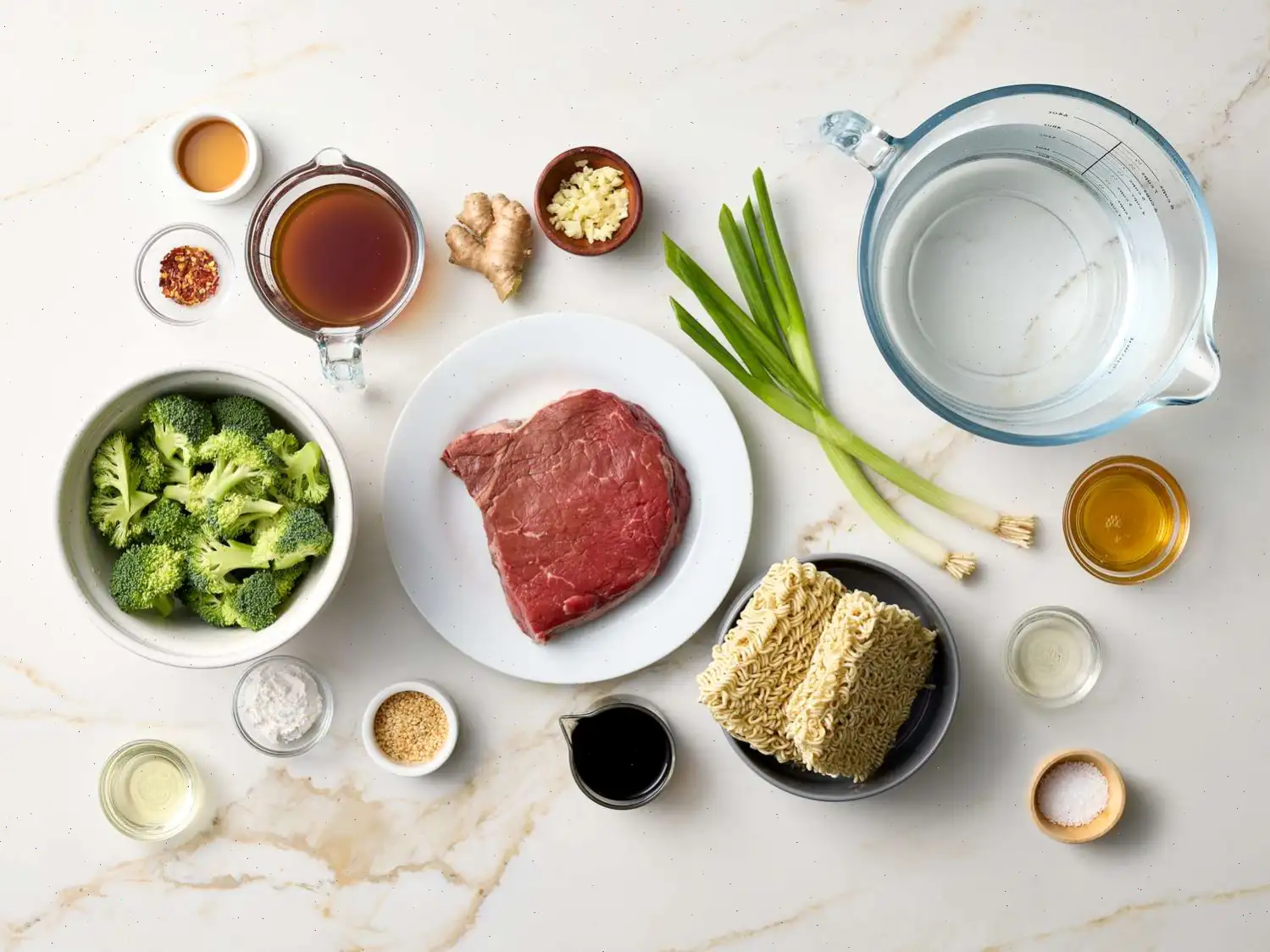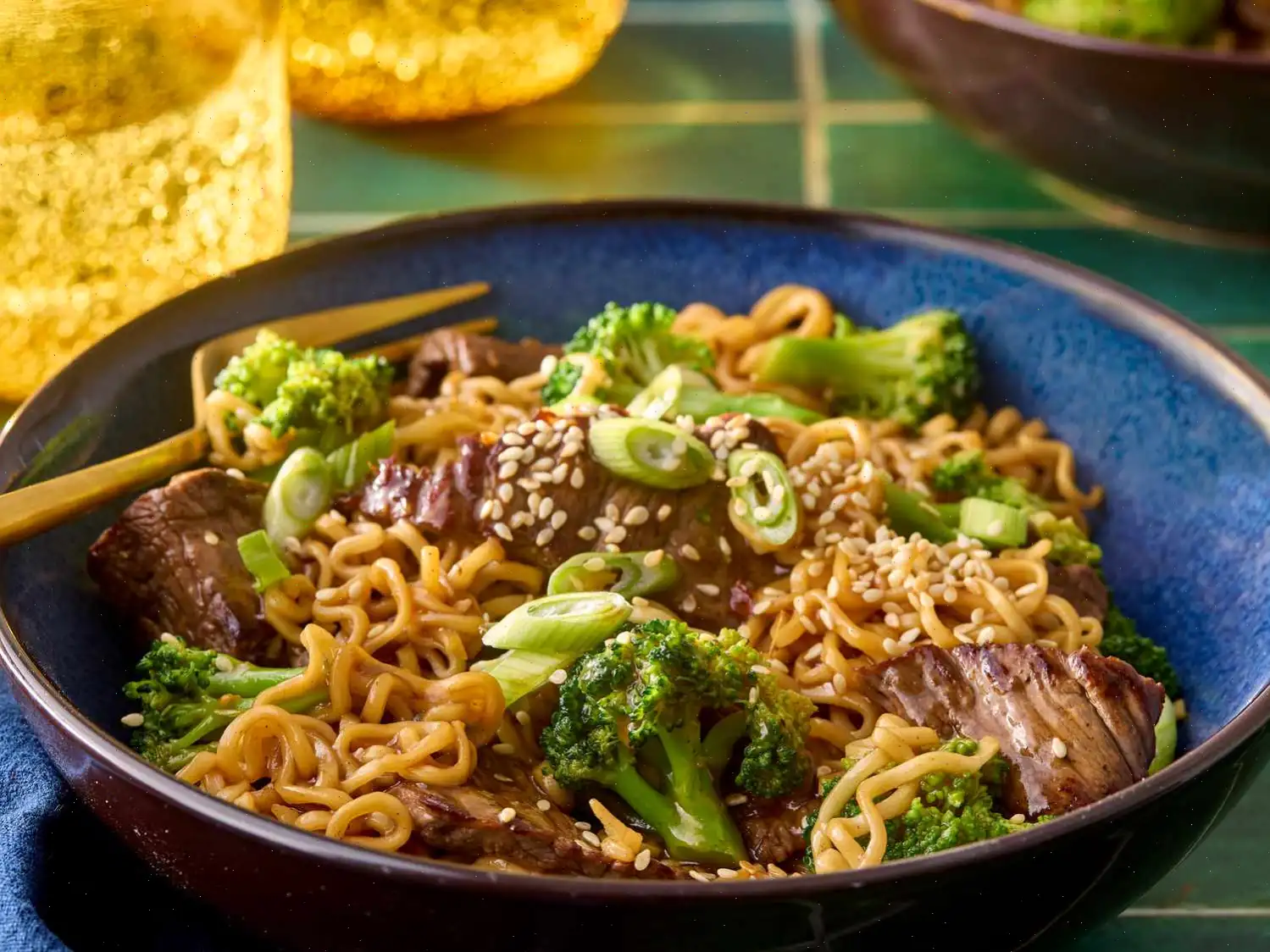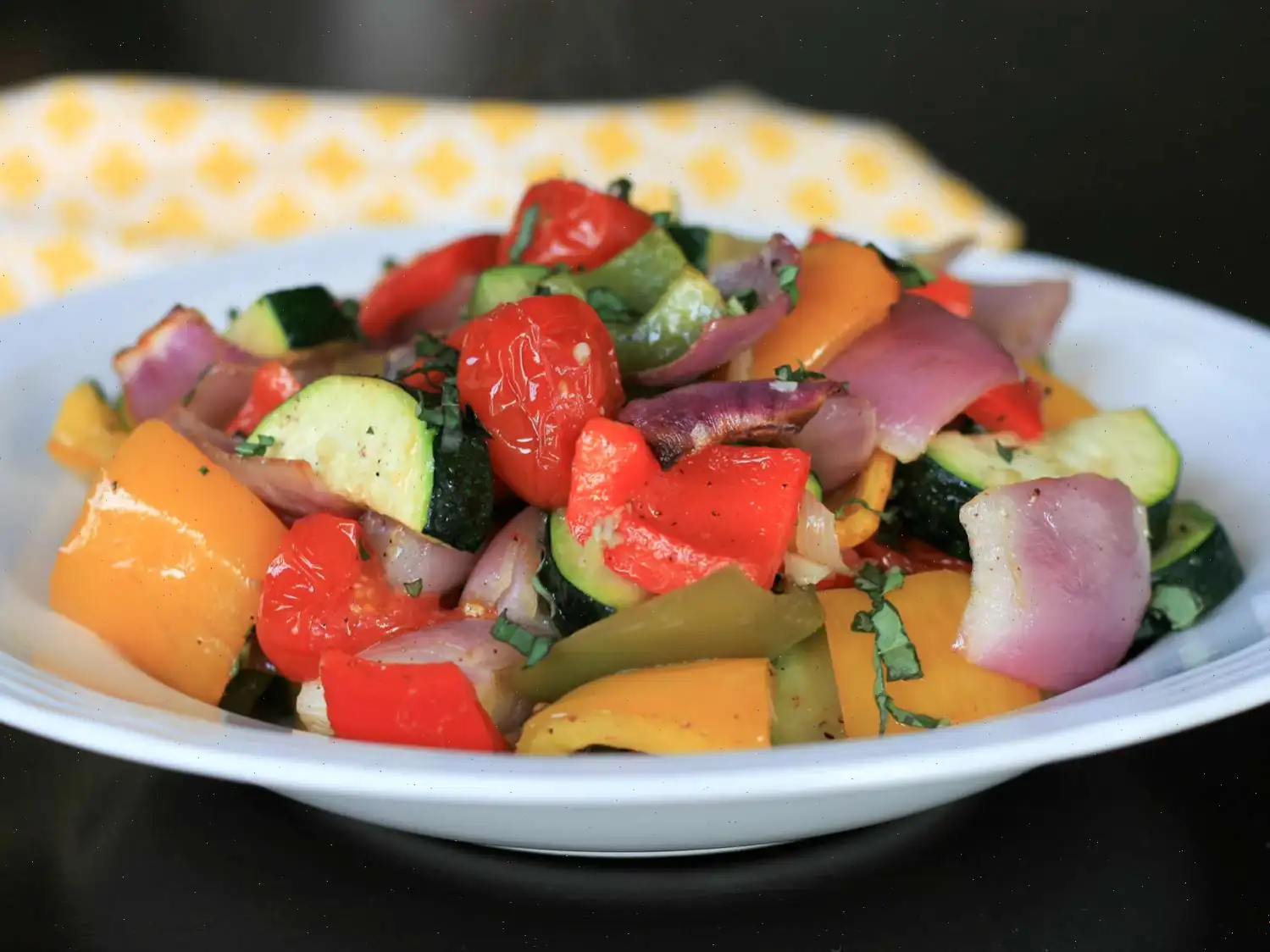
Beef and Broccoli Ramen Stir Fry Recipe
Ingredients
- 1/2 cup lower sodium beef broth
- 1/4 cup reduced-sodium soy sauce
- 2 tablespoons honey
- 1 tablespoon cornstarch
- 1 tablespoon rice vinegar
- 2 teaspoons grated fresh ginger
- 2 cloves garlic, minced
- 2 teaspoons toasted sesame oil
- 1/4 teaspoon crushed red pepper
- 6 cups water
- 2 (3-ounce) packages instant ramen noodles (discard seasoning packets)
- 3 cups broccoli florets
- 1 tablespoon vegetable oil
- 1 pound beef sirloin steak, thinly sliced into bite-sized strips
- 1/4 teaspoon salt
- 1/4 cup chopped green onions
- 2 teaspoons toasted sesame seeds
Directions
- Start by gathering all your ingredients and setting them out for easy access.
- In a small bowl, whisk together the beef broth, soy sauce, honey, cornstarch, rice vinegar, grated ginger, minced garlic, sesame oil, and crushed red pepper to make the sauce.
- Bring 6 cups of water to a boil in a large saucepan. Break each ramen noodle bundle into four smaller pieces for easier cooking. Add the ramen noodles and broccoli florets to the boiling water, omitting the seasoning packets. Cover and cook for 3 minutes, stirring occasionally. After 3 minutes, drain the noodles and broccoli and set aside.
- Heat 1 tablespoon of vegetable oil over medium-high heat in a 12-inch skillet. Season the thinly sliced beef sirloin steak with 1/4 teaspoon salt. Add the steak strips to the skillet and stir-fry for about 2 minutes, or until the steak is browned. Once browned, remove the steak from the skillet and set aside.
- In the same skillet, add the sauce mixture and cook, stirring, for 2 minutes until the sauce thickens and starts to bubble.
- Return the cooked steak and the drained ramen noodles and broccoli to the skillet. Toss everything together to combine and heat through, stirring for another 1 minute.
- Garnish your dish with chopped green onions and toasted sesame seeds. Serve and enjoy!
Nutrition Facts (per serving)
- Calories: 440
- Total Fat: 24g (31% DV)
- Saturated Fat: 8g (39% DV)
- Cholesterol: 104mg (35% DV)
- Sodium: 1055mg (46% DV)
- Total Carbohydrates: 21g (8% DV)
- Dietary Fiber: 3g (10% DV)
- Total Sugars: 10g
- Protein: 35g (71% DV)
- Vitamin C: 39mg (43% DV)
- Calcium: 86mg (7% DV)
- Iron: 3mg (18% DV)
- Potassium: 666mg (14% DV)
*Percent Daily Values are based on a 2,000 calorie diet. Your daily values may be higher or lower depending on your calorie needs.

The Cultural Journey of Beef and Broccoli Ramen Stir Fry
Beef and broccoli ramen stir fry is a modern fusion dish that reflects the blending of Asian culinary traditions with contemporary convenience cooking. Its origins can be traced to the popularity of Chinese-American cuisine, particularly the classic beef and broccoli stir fry. In the mid-20th century, Chinese immigrants adapted traditional recipes to suit American tastes, often adding soy-based sauces, sugar, and cornstarch to create a glossy, flavorful coating for tender beef and crisp broccoli. The introduction of instant ramen noodles, which became widely available in the United States in the 1970s, offered a quick and affordable way to complete the dish, resulting in the beloved stir fry we know today.
Regional Variations
While the foundational elements of beef, broccoli, and noodles remain consistent, regional variations abound. In the United States, some chefs enhance the sauce with hoisin or oyster sauce, adding a sweeter or more umami-rich depth. West Coast versions might include additional vegetables such as bell peppers or snow peas, reflecting the abundance of fresh produce. In contrast, East Coast adaptations often emphasize a spicier profile, incorporating crushed red pepper or Sriracha for heat. In Asia, chefs sometimes substitute ramen with lo mein or udon, and the dish is often lighter, focusing on the natural flavors of the beef and broccoli rather than a thickened sauce.
Distinctive Characteristics Compared to Similar Dishes
Unlike traditional beef and broccoli stir fry served with rice, the addition of ramen noodles provides a more filling, one-pan meal experience. The noodles absorb the savory sauce, creating a cohesive dish where the beef, vegetables, and starch are integrated. Compared to lo mein, which often uses pre-cooked noodles and a more complex sauce, beef and broccoli ramen stir fry is quicker to prepare, emphasizing speed and simplicity without sacrificing flavor. Its versatility also sets it apart, allowing home cooks to adjust sweetness, spice, or vegetable variety easily.
Typical Serving Settings
Beef and broccoli ramen stir fry is commonly served at home as a convenient weeknight dinner, appreciated for its balance of protein, vegetables, and carbs. It has also found a place in casual dining establishments, food trucks, and college cafeterias due to its fast preparation and crowd-pleasing taste. Garnished with toasted sesame seeds and fresh green onions, it is visually appealing and often paired with a light soup or pickled vegetables to complete the meal.
Fun Facts and Culinary Insights
- The dish showcases the adaptability of instant ramen, which was originally marketed as a budget-friendly, shelf-stable staple but has since become a versatile ingredient in gourmet home cooking.
- Broccoli was incorporated into Chinese-American cuisine as a substitute for traditional Chinese greens, chosen for its availability and mild flavor.
- The quick-cooking nature of ramen ensures that both the noodles and vegetables retain texture, demonstrating a balance of convenience and culinary technique.
- Many home cooks add a touch of toasted sesame oil at the end to enhance aroma and authenticity, a nod to East Asian cooking traditions.
- The dish illustrates how fusion cuisine evolves over decades, combining the practicality of instant noodles with the classic stir-fry method.


